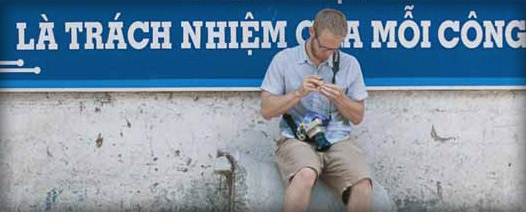
Interview with Evan Baden<br><i>“The faces and gestures of those who drive innovation”</i>
Interview with Evan Baden
“The faces and gestures of those who drive innovation”
“The faces and gestures of those who drive innovation”

Evan Baden (American b. Saudi Arabia, 1985)
Evan Baden earned his B.F.A from the College of Visual Arts in St. Paul, Minnesota, US in 2007.
Since 2006 he has created two bodies of work, The Illuminati and Technically Intimate. They have been exhibited internationally with museums and galleries throughout Europe and the United States.
His work is held in the collections of the Walker Art Center, Milwaukee Art Museum, and Museum of Contemporary Photography.
His work has appeared in numerous publications including TIME, The Guardian, FOAM, New York Magazine, Le Monde, D della Repubblica, Geo, and DIE ZEIT.
In 2008, he won the Jerome Fellowship for Emerging Artists. He has been a finalist for the McKnight Fellowship for Photography and nominated for the Baum Award for Emerging American Photographers.
Your major photography projects, “The Illuminati” and “Technically Intimate”, focus on youth, technology and communication. With this background, how did you approach this photographic story for Datalogic’s fortieth anniversary?
My work normally deals with young people and how they use technology to communicate and to shorten long distances, often creating an illusion of closeness. The theme set for me from the beginning of this project, however, was that of innovation. I was not certain of how to successfully convey this through images. Then I was inspired to switch the focus onto the people who work for the company and who contribute to the goal of innovation. I knew the subjects would be different, that is to say, they would not only be young people: but their work, being highly technical and carried out all over the world, even on shared projects, is a great representation of the concept of communication.
What is the underlying story of this collective portrait?
The fact that the term ‘innovation’ can be abused, an empty word. These are people sharing a plan of action, each doing their part, to make this idea a reality. It doesn’t matter whether they work in a shop or an office, design scanners or produce only a part of them: what matters is that they all work on one big project. What I have seen, and what I hope to convey through my photos and the juxtapositions of people and places within the book, is that it is never a case of just one person coming up with an idea, which is then given shape by other people who simply carry out instructions. Everyone, from every part of the world, contributes with equal dignity to creating innovation.
The people portrayed are all posed, as if they were the main protagonists of a film, the film of Datalogic. Is this impression correct?
My work usually depicts arranged scenes, while here it involves posed subjects. This is because my photos are intended to suggest that there is a wider story outside of the photograph, as if the single image is no more than a cinematographic fragment of what is happening in that moment.
Do you think that photography could be defined as a universal language?
Much more than writing or film (where the latter is tied to language), photography speaks to us all, especially when it comes to portraits: there is a language between subject and viewer, based on expressions and gestures, that entails an immediate understanding, a relationship that is not possible in any other art form. The language of gestures captured in a photograph creates a very strong rapport between the two people involved, even though one is real and the other is only an image.
The first project you worked on is entitled “The Illuminati”: it has travelled all over the world and been extremely successful. Why do you think that is?
Again, this success derives from the universal nature of photography. In this project I was dealing with the complex subject of the relationship between people and the isolation that can result from extensive use of technology. It is very difficult to communicate this theme through other art forms. The photographs of the “illuminati” are very simple images, where meaning is largely conveyed through the use of light to illuminate their faces. The photographs are mostly dark, with the concepts of communication and solitude concentrated on one single point, together with the perception of what is about to happen in the mind of the protagonist.
Many galleries around the world have exhibited your work, always printed in large dimensions. What relationship do you want to create between the viewer and your image?
I want the viewer to identify with the protagonist in my work. A rapport is born between the two of them so that the person depicted is seen not as a work of fiction, but as a real human being.
What does photography mean in your life?
In my day-to-day life, photography does not play a particular role, as I don’t take photographs when I am out and about. For me, photography is an instrument with which to express certain ideas about culture, and to communicate them to a wider audience: many people do not easily get involved with the art world, finding it remote, but photography is a more understandable form of communication. After all, everyone is a photographer these days – you just need a mobile phone. For me, however, photography is a slow process, of planning and of profound meditation on the concept to be expressed.
by Francesca Parisini
